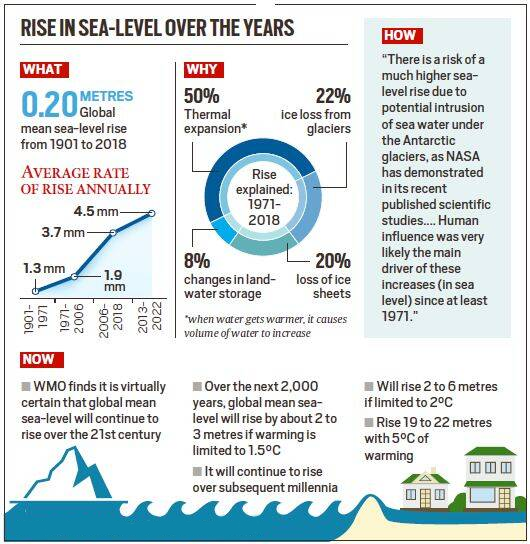Biodiversity & Environment
Global Sea-level Rise and Implications: WMO
- 15 Feb 2023
- 6 min read
Prelims: WMO, Climate Crisis, Global Warming, Coastal Ecosystems.
Mains: Global Sea-level Rise and Implications.
Why in News?
According to the World Meteorological Organisation ‘s (WMO) Report “Global Sea-level Rise and Implications”, India, China, Bangladesh and the Netherlands face the highest threat of sea-level rise globally.
- Several big cities on all continents are threatened by the rise in sea level.
- These include Shanghai, Dhaka, Bangkok, Jakarta, Mumbai, Maputo, Lagos, Cairo, London, Copenhagen, New York, Los Angeles, Buenos Aires and Santiago.
What are the Highlights of the Report?
- Trends and Projections:
- Between 2013 and 2022, Global mean sea-level was 4.5 mm/year and human influence was likely the main driver of these increases since at least 1971.
- Global mean sea-level increased by 0.20m between 1901 and 2018,
- 1.3 mm/ year between 1901 and 1971,
- 1.9 mm/year between 1971 and 2006
- 3.7 mm/year between 2006 and 2018.
- Even if global heating is limited to 1.5 degrees Celsius over pre-industrial levels, there will still be a sizable sea level rise.
- But every fraction of a degree counts. If temperatures rise by 2 degrees, that level rise could double, with further temperature increases bringing exponential sea level increases.
- Between 2013 and 2022, Global mean sea-level was 4.5 mm/year and human influence was likely the main driver of these increases since at least 1971.
- Contributors to Sea Level Rise:
- Thermal expansion contributed to 50% of sea level rise during 1971-2018, while ice loss from glaciers contributed to 22%, ice-sheet loss to 20% and changes in land-water storage 8%.
- The rate of ice-sheet loss increased by a factor of four between 1992-1999 and 2010-2019. Together, icesheet and glacier mass loss were the dominant contributors to global mean sea level rise during 2006-2018.
- Impacts:
- At sustained warming levels between 2-3 degree Celcius, the Greenland and West Antarctic ice sheets will be almost completely and irreversibly lost over multiple millennia causing potentially multimeter sea-level rise.
- Sea-level rise will bring cascading and compounding impacts resulting in losses of coastal ecosystems and ecosystem services, groundwater salinization, flooding and damage to coastal infrastructure that cascade into risks to livelihoods, settlements, health, well-being, food, displacement and water security, and cultural values in the near to long-term.
What is the Scenario for India?
- Rate of Sea Level Rise:
- According to the Ministry of Earth Sciences, on average, the sea level along the Indian coast was observed to be rising at a rate of about 1.7 mm/year during the last century (1900-2000).
- A 3 cm sea level rise could cause the sea to intrude inland by about 17 meters. At future rates of 5 cm/decade, this could be 300 metres of land taken by the sea in a century.
- India is more Susceptible:
- India is most vulnerable to compounding impacts of sea level rise.
- In the Indian ocean half of sea level rise is due to the volume of water expanding since the ocean is warming up rapidly.
- The contribution from glacier melt is not as high.
- The Indian Ocean is the fastest warming ocean in terms of surface warming.
- Implications:
- India is facing compound extreme events along our coastline. Cyclones are intensifying rapidly due to more moisture and heat from ocean warming.
- The amount of flooding also increases because storm surges are compounding sea level rise decade by decade.
- Cyclones are bringing more rain than earlier. Super Cyclone Amphan (2020) caused large-scale flooding and inundated tens of kms inland with saline water intruding.
- Over time, the Indus, Ganga and Brahmaputra rivers may shrink, and rising sea levels combined with a deep intrusion of saltwater will make large parts of their huge deltas simply uninhabitable.
What are the Recommendations?
- There is a need to address the climate crisis and broaden our understanding of the root causes of insecurity.
- It is imperative to actively support grassroots resilience efforts to tackle climate change and improve Early Warning Systems.
What is the World Meteorological Organization (WMO)?
- The WMO is an intergovernmental organization with a membership of 192 Member States and Territories.
- India is a member of WMO.
- It originated from the International Meteorological Organization (IMO), which was established after the 1873 Vienna International Meteorological Congress.
- Established by the ratification of the WMO Convention on 23rd March 1950, WMO became the specialized agency of the United Nations for meteorology (weather and climate), operational hydrology and related geophysical sciences.'
- WMO is headquartered in Geneva, Switzerland.
UPSC Civil Services Examination, Previous Year Question (PYQ)
Q. ‘Climate change’ is a global problem. How India will be affected by climate change? How Himalayan and coastal states of India will be affected by climate change? (2017)





